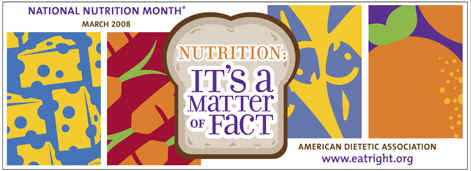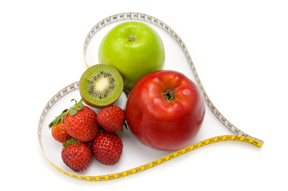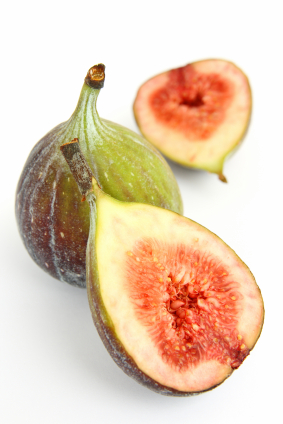Spring 2008: To Your Health
In this Issue:
- Celebrating the 27th Anniversary of National Nutrition Month
- How Eating Breakfast Can Benefit Children
- The Link Between a Healthy Diet & Cancer
- The Best Foods for Spring
- Eat Your Way to a Good Night’s Sleep
- Feature Food of the Month: Figs
- Healthy Recipe: Fig and Oat Bars
Celebrating the 27th Anniversary of National Nutrition Month

The first National Nutrition Month Campaign was launched in 1973 by the American Dietetic Association (ADA) as an opportunity to focus attention on the importance of making knowledgeable food choices and developing healthy eating and physical activity habits. Each year, the theme of National Nutrition Month has differed. This year in 2008 the message to the public in order to achieve a healthful lifestyle is “Nutrition: It’s a Matter of Fact.” The ADA urges individuals to look past the myths of nutrition and to focus on the facts:
- Good nutrition advice is based on science. Be sure that the information you receive is based on scientific fact before making any changes in your diet.
- The best way to manage your weight and promote overall health and fitness is to balance a healthy diet with physical activity.
- Prepare and store foods safely by following proper food storage techniques in order to protect you and your family from food-borne illness.
- Utilize food labels as a tool to help you make smart food choices easily and quickly.
- Instead of grouping foods into the “good” or “bad” category, focus on consuming low calorie foods that are rich in nutrients such as vitamins, minerals, and fiber.
- No single food or meal will ultimately make or break your healthy diet, but rather focus on your overall intake.
- Choose healthy fats (monounsaturated and polyunsaturated fats) over saturated and trans fats in order to help keep your cholesterol low.
- Beware of food myths, misinformation, and fad diets that may compromise your health. Consult with a registered dietitian to learn the facts about healthy eating.
Registered dietitians are your most valuable and credible source of timely, scientifically based food and nutrition information.
Ten Reasons Why Consulting with a Registered Dietitian Can Benefit You:
- You have diabetes, cardiovascular problems or high blood pressure.
- You are thinking of having or have had gastric bypass surgery.
- You have digestive problems.
- You’re pregnant or trying to get pregnant.
- You are (or thinking of) breastfeeding your baby.
- Your teenager has issues with food and eating healthfully.
- You need to gain or lose weight.
- You want to eat smarter.
- You want to improve your performance in sports or regular physical activity.
- You are caring for an aging parent.
Source: American Dietetic Association
MARCH 10TH IS REGISTERED DIETITIAN DAY!
The ADA announced the first-ever Registered Dietitian Day being celebrated on March 10th. Registered Dietitians are experts in food and nutrition and are committed to translating this science into practical solutions for individuals, providing the tools necessary to live a healthy lifestyle.
Click here to see how Bonnie R. Giller, MS, RD, CDN, CDE can help you!
How Eating Breakfast Can Benefit Children

A recent study published in the Journal of the American Dietetic Association suggests that a nutritious breakfast is essential for the growth and development of children. The nutrients provided in a nutritionally balanced breakfast provide the necessary elements to ensure a constant release of energy throughout the day, as well as delaying the onset of hunger. In addition, a good breakfast helps children to:
- Learn better since nutrition helps to boost memory and may lead to higher academic achievements
- Participate in class since proper nutrition increases attentiveness
- Attend school more often (less absences)
- Behave better and are more apt to developing socially
- Visit the school nurse less often since good nutrition boosts the immune system
- Maintain a healthy weight as they grow older
- Establish healthy eating behaviors
Tips to Get Your Kids to Eat Breakfast
- Set a good example.As a parent, it’s important to understand that your behavior impacts your children. The more your child sees you eating a nutritious meal each morning, the more likely they are to develop healthy eating habits. If possible, sit down as a family to have breakfast each morning.
- Prepare a weekly breakfast menu.At the end of each week, pre-plan each breakfast for the following week in order to save time and energy each morning. Visualizing your meals makes it easier to develop the habit and stick with it!
- Wake up.Set your child’s alarm clock a half-hour earlier than their normal wake-up time to allow enough time to prepare and eat breakfast.
- Let them participate.When children are involved in an activity, they are more likely to stick to it. If they are younger, allow them to pour the cereal into the bowl or cut out shapes for their toast. If they are older, allow them to prepare their own nutritionally balanced breakfast.
Healthy Breakfast Choices
- Hard boiled eggs:Boil the night before and serve with a slice of whole grain toast.
- Whole grain cereal:Serve with low-fat milk and top with fruit.
- Oatmeal:Prepare with skim milk and top with cinnamon and fruit (i.e. apples or raisins)
- Fruit yogurt shake:Mix 1 scoop of nonfat frozen yogurt, ½ cup sliced fruit, and 1 cup of ice cold skim milk in a blender.
- Low-fat waffles:Top with fruit and serve with skim milk.
- Whole grain bagel or toast:Top with peanut butter or low-sugar jam.
- Cinnamon apple wrap:Take four 7-inch whole wheat tortillas, ½ cup unsweetened applesauce, ½ cup reduced fat shredded cheese, 1 tbsp. cinnamon, and 1 tbsp. sugar. Mix the sugar and cinnamon together. Spread 1/8 cup of applesauce over each tortilla, then sprinkle ½ tbsp. of the cinnamon/sugar mixture on the applesauce. Top it with 1/8 cup of low-fat shredded cheese. Fold the tortillas and microwave until the cheese melts. Enjoy with the whole family.
Reference: Affenito, Sandra. Breakfast: A Missed Opportunity. Research editorial. J Am Diet Assoc. 2007: pages 565-569.
Visit our special web section for delicious breakfast ideas for adults!
The Link Between a Healthy Diet & Cancer

As the number two leading cause of death in the United States, cancer is a concern for many. According to the American Cancer Society, about 550,000 Americans die from cancer each year and it is believed that one third of these deaths are associated with poor diet, physical inactivity, and being overweight. Luckily these are risks that can be controlled through motivation and lifestyle changes. Here are some important key points to remember when thinking about the relationship between a healthy diet and your risk for cancer:
Eat a Healthy Diet
- Increase your intake of fruits and vegetables. Fruits and vegetables have been shown to contain phytochemicals and antioxidants known to have disease-fighting abilities. Eating at least 5-9 servings of fruits and vegetables per day can help prevent several cancers. Fruits and vegetables with the most color, which is a sign of high nutrient content, are your best choices. These foods are very high in vitamins, minerals, phytochemicals, and antioxidants which all work together to help keep you healthy and at a lower risk for developing cancer.
- Eat more whole grains. It is important to incorporate at least 3 servings of whole grains into your diet each day. Whole grains are high in fiber which has been shown to help prevent colon cancer. Consuming at least 3 servings of whole grains per day may also help with weight management, a risk factor for cancer. Whole grains include any of the following: whole-wheat flour, bulgur (cracked wheat), oatmeal, whole cornmeal, and brown rice.
- Limit your intake of processed and red meats. It is believed that cutting back on processed meats such as hot dogs, bologna, cold cuts, and red meats like beef, pork, and lamb will help to reduce the risk of certain cancers such as colon and prostate cancers. These foods are preserved by methods using smoke and salt which increases the exposure to potential cancer-causing agents. They also contain nitrates which may contribute to an increased risk.
- Limit your intake of alcoholic beverages.Alcohol is known to increase the risk of cancers of the mouth, pharynx (throat), larynx (voice box), esophagus, liver, and breast, and possibly of the colon and rectum. Alcohol intake should be limited to no more than 2 drinks per day for men and 1 drink per day for women. A drink is defined as 12 ounces of beer, 5 ounces of wine, or 1.5 ounces of 80-proof distilled spirits.
Maintain a Healthy Weight
Being overweight has been associated with an increased risk of cancer such as breast cancer, colon cancer, endometrial cancer, esophageal cancer and cancer of the kidneys. When you are overweight your body produces and circulates more of the estrogen and insulin hormones which can stimulate cancer growth.
Here are some important tips on how to maintain a healthy weight:
- Increase the amount of fruits and vegetables you consume a day
- Choose foods lower in total and saturated fat
- Portion control is extremely important to weight loss; slightly smaller portions can help shed some excess pounds
- Eliminate soft drinks or other drinks high in sugar to avoid empty calories
- Increase your intake of fiber to help you stay full longer and to eat less throughout the day
- Drink more water as this will also help you to feel full longer
Become More Active
- 30-60 minutes of intentional exercise per day can help with weight loss
- Walking, biking, yoga are all good choices for exercise
- Parking your car farther away in the parking lot will help you burn more calories
- Avoid spending a lot of time in front of the TV or computer
- Take up a hobby such as gardening, dancing or golfing
- If weather permits, walk rather than drive to your destination
Reference: American Cancer Society
Visit our special web section for tips on how to include more fruits, vegetables, and whole grains into your diet, and for a list of alternatives to processed and red meats.
APRIL IS CANCER CONTROL MONTH
Cancer Control Month serves to raise awareness of Americans about cancer, education about treatments, and to help renew the commitment to fighting this disease. Get involved this month and help work towards a cure.
The Best Foods for Spring

As the cold winter months fade and the soil begins to lose its frost, spring represents a time where things begin to bloom…including fresh fruits and vegetables! Here are some of the best foods spring has to offer:
Asparagus:Known as one of the most nutritionally well-balanced vegetables, the asparagus plant is part of the lily family which also includes onions, garlic, and leeks. This crop is best grown in the sandy, well-drained soils of Michigan from April through June. Asparagus is an excellent source of folate, vitamin C, and a good source of vitamin A. In fact, 5 ounces of cooked asparagus provides 20 calories, 0 grams of fat, 2 grams dietary fiber, and 3 grams of protein. Asparagus can be served as an appetizer, a side dish, and in main entrees, such as with pasta.
Artichokes:Originating in Sicily, the artichoke is the flower bud of a thistle-like plant that belongs to the sunflower family, and is commonly eaten as a vegetable. The prime season for the artichoke is from March to May, even though they may be seen in supermarkets year-round. Artichokes are an excellent source of fiber, folate, and vitamin K, and are also a good source of vitamin C. One medium artichoke contains approximately 60 calories, 3 grams of protein, 0 grams of fat, and 10 grams of dietary fiber. Artichokes are typically eaten as appetizers, as a side dish, and in main entrees.
Apricots:Originating from China, this delicate fruit is in the same family as the peach, yet is more fragrant and sweet. Their peak season is short and the apricot tree typically reaches maturity in May or June. Apricots are one of the best sources of vitamin A—an antioxidant which is essential for healthy skin, good vision, and may help prevent heart disease. Apricots are also a good source of vitamin C and dietary fiber. One apricot contains approximately 67 calories, 0 grams of fat, 1 gram of protein, and 3 grams of dietary fiber. They can be poached, grilled, added to desserts or can be savored on their own!
Cherries:This sweet, yet tart fruit belongs to the same family as peaches, plums, and apricots and is grown all over the world. Cherries contain antioxidants called anthocyanins—natural compounds that not only contribute to their red pigment, but have also been shown to reduce inflammation and protect against heart disease. Sour red cherries are an excellent source of vitamin A and are also a good source of vitamin C and dietary fiber. One cup of cherries provides approximately 77 calories, 0 grams of fat, 1.5 grams of protein, and 3 grams of dietary fiber. Cherries can be savored as is or can be added to desserts.
Mango:This fruit is native to south Asia and requires warm, dry weather to grow plentiful. In addition, the mango is one of the most commonly eaten fruits in tropical countries. Mangoes are typically oval or round in shape and the skin often has an orange-red color with a golden yellow flesh. They have the best flavor when allowed to ripen on the tree and soften, then they are picked to enjoy! One mango contains approximately 130 calories, 0 grams of fat, 1 gram of protein, and 4 grams of dietary fiber. They are also high in vitamin A and C. Mangoes can add unique flavor to smoothies, salads, desserts, and salsas.
Spinach:Spinach belongs to the same family as beets and chard and typically has a bitter flavor. Fresh spinach has a delicate texture and a bright green color that can add refreshing color to many dishes. Three types of spinach include savoy (crisp, curly leaves), smooth-leaf (unwrinkled, flat leaves), and baby spinach which is most commonly used in salads and has a sweeter taste. Spinach can be eaten raw or cooked briefly (to maintain its color). One-half cup of boiled spinach contains approximately 20 calories, 0 grams of fat, 3 grams of protein, and 2 grams of dietary fiber. Spinach is an excellent source of folate, vitamin A, vitamin K, as well as a good source of iron and vitamin C.
Recipes to Remember:
Heart Healthy Can Be Delicious CookbookThis heart-healthy cookbook is good for all diets. It contains 200 recipes your heart will love along with nutritional analysis and diabetic exchanges.
See sample recipes by clicking here.This cookbook is ideal for those counting carbs, calories, fat or food groups.
Eat Your Way to a Good Night’s Sleep

Insomnia is often referred to as a difficulty falling asleep or waking up frequently throughout the night. Short-term insomnia can occur during times of stress or if your environment is too bright or noisy, and can be easily treated. However, chronic insomnia may be a response to a lifestyle habit, medical condition, or a psychological disturbance, and can cause you to feel fatigued and unable to focus. Research suggests that by combining the right foods with those foods to avoid, your insomnia can be a thing of the past.
Things to Avoid Before Bedtime:
- Large meals:Your digestion slows down when you lay down to go to sleep, so consuming a large meal or snack before bedtime will make you feel uncomfortable and may keep you from getting to sleep. To avoid this discomfort, avoid eating a large bedtime snack or heavy dinner at least 3 hours before bedtime.
- Caffeine:Caffeine is a natural stimulant found in soft drinks, tea, coffee, and chocolate that activates the central nervous system and your thought processes. Individuals who are sensitive to caffeine should avoid drinking it too close to bedtime (as much as 8 hours before) since caffeine can make you feel jittery and prevent you from falling asleep. Experiment with your own particular timing to discover your individual tolerance.
- Alcohol:The relaxing effect that alcohol may have on some people will eventually wear off, often in the middle of the night, preventing you from having a good night’s sleep. Try to omit alcohol for a few weeks to determine if your sleep disturbances resolve.
- Liquids:If your sleep disturbances are caused by frequent visits to the bathroom in the
middle of the night, avoid drinking liquids an hour and a half before bedtime. If you need to take medication, take a small sip of water instead of gulping a whole glass.
Foods to Eat to Ensure a Restful Sleep:
Tryptophan is an amino acid that helps to produce serotonin—a brain chemical that gives off a calm, sleepy effect on the body. Research suggests that consuming tryptophan-containing foods with carbohydrates may help to resolve insomnia by making this amino acid more available to the brain, thus encouraging sleepiness.
Here are some examples of foods to eat to ensure a restful sleep:
- 6 oz. non-fat flavored yogurt
- ½ cup low-fat pudding
- Whole-grain cereal with non-fat milk
- ½ turkey sandwich
- Oatmeal made with milk
- Apple slices with peanut butter
While there may be herbal supplements available to help combat insomnia, it’s important to talk with your doctor if you are considering this as an alternative.
- Click here for information on how your sleeping patterns can affect your weight.
Feature Food of the Month: Figs

The fig, commonly known for their spotlight in the Fig Newton bar, is originally from Asia and is one of the first fruits ever cultivated. Although considered a fruit, the fig is actually an inverted flower which blooms inside itself. They are the only fruit to ripen on the tree.
Dried figs are available year round, but there is nothing like biting into a fresh fig. Unfortunately, fresh figs are extremely perishable and should be eaten as soon as possible. Ripe figs will stay in the refrigerator for about two days, though they must be handled with extreme caution as they bruise and dry out easily. For those of you who want to enjoy the fig with ease, dried figs are the way to go. Caution should be taken though because dried figs are 5 times higher in calories than fresh figs.
Figs are highly nutritious and are an excellent source of dietary fiber, calcium, iron and potassium, as well as benzaldehyde (anti-cancer compound). In addition, they contain a digestive enzyme called ficin which aids in the digestion of proteins. Fig crops are cultivated in mid-to-late spring as well as in the late summer. Fresh figs are paired well with dessert wines, can be grilled on the barbeque, and are great as jams and jellies.
Healthy Recipe – Fig and Oat Bars
Ingredients for the Base:
¾ cup whole wheat flour
¼ cup oat bran
½ cup all-purpose flour
1 tsp. baking powder
¼ tsp. salt
1/3 cup Splenda for Baking
1 tsp. vanilla extract
1 egg white
¼ cup skim milk
¼ cup unsweetened applesauce
Ingredients for the Filling:
½ cup chopped dried figs
½ cup dates
1 cup chopped dried prunes
½ cup raisins
Boiling water
Ingredient for the Topping:
½ cup low-fat granola
Instructions:
1. Pre-heat the oven to 350 F.
2. Cover the filling ingredients with boiling water. Cover and let stand for 5 minutes.
3. In a bowl, combine all dry ingredients for the base.
4. In a separate bowl, combine all wet ingredients.
5. Add the combined wet ingredients into the dry ingredients and mix thoroughly.
6. Spread the base mixture into a square pan that has been floured.
7. Stir the fruit filling until it is smooth and has a consistency similar to that of applesauce.
8. Spread the fruit filling over the base and top with low-fat granola.
9. Bake for 18-20 minutes.
Yield: 16 servings
Serving Size: 1 bar
Exchange: 1 Starch, 1 Fruit
Nutrition Facts:
Calories = 141
Total Fat = 0 grams
Saturated Fat = 0 grams
Cholesterol = 0 grams
Carbohydrate = 33 grams
Protein = 3 grams
Sodium = 126 milligrams
Dietary fiber = 3 grams
For more healthy recipes, click here.


Leave a Reply
Want to join the discussion?Feel free to contribute!